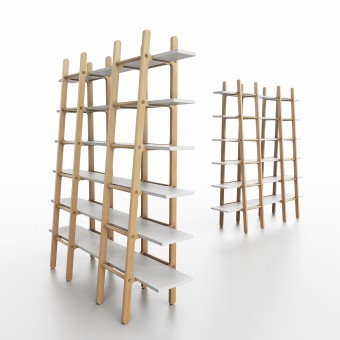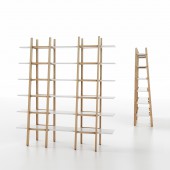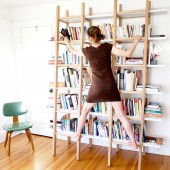
| THE AWARD |
| CATEGORIES |
| REGISTRATION |
| SUBMIT YOUR WORK |
| ENTRY INSTRUCTIONS |
| TERMS & CONDITIONS |
| PUBLICATIONS |
| DATES & FEES |
| METHODOLOGY |
| CONTACT |
| WINNERS |
| PRESS ROOM |
| GET INVOLVED |
| DESIGN PRIZE |
| DESIGN STORE |
| THE AWARD | JURY | CATEGORIES | REGISTRATION | PRESS | WINNERS | PUBLICATIONS | ENTRY INSTRUCTIONS |
Huxley's Ladder Book Shelf by Marc Scimé |
Home > Winners > Design #42647 >Interview |
 |
|
FS: What is the main principle, idea and inspiration behind your design?
MS: The principle inspiration for the invention of Huxley's Ladder was necessity. In the second term of my graduate level studies at Art Center College of Design I was assigned a design project for storage. At home, I already had more books than I had room for and I was acquiring more art and design books by the week. I needed to better utilize limited space in my home to create more shelves for these books. Ceilings are typically 2.44 meters high or greater. The other bookshelf I have is only about half that height thus fails maximize use of space. The obvious solution was to go up!
FS: What has been your main focus in designing this work? Especially what did you want to achieve?
MS: I want to increase better use of space in a room by making a way to have more bookshelves without increasing the footprint. But with that being said, not only should the design be functional it should also be fun. The ladder does both. What makes Huxley's Ladder fun is also what makes the design functional or vice versa.
FS: What are your future plans for this award winning design?
MS: At a minimum, I have the book shelf space I need now and perhaps I'll make another in the future. I'd also like to further refine the design and utilize the form language to create a collection of tables and bench type seating. Ultimately my ideal out come would be to find a good company known for just making high-quality hardwood furniture to put the bookshelves or perhaps the whole collection into production. I'd love to show this to Maurizio Riva if would be so kind to look at it.
FS: How long did it take you to design this particular concept?
MS: The basic concept took a few minutes. The rest of the design process, including hand made mockups of details, development and 3D CAD work took a few days. The full process from concept to realizing the completed functioning prototype took about 6 or 7 weeks.
FS: Why did you design this particular concept? Was this design commissioned or did you decide to pursuit an inspiration?
MS: As I've said, the reason for designing Huxley's Ladder was necessity - my second term my graduate level assignment to design some kind of furniture or object for storage and my desperate need for more spaces to put all of my books at home. Many were sitting in boxes waiting for a proper place.
FS: Is your design being produced or used by another company, or do you plan to sell or lease the production rights or do you intent to produce your work yourself?
MS: I have the one prototype now but it is not as of yet in production or licensed to any other company. I have no intention of producing more myself to sell. I'd rather spend my time designing new things because I'm a designer, not really a furniture maker. If I can find a good company to license the design to for product I think that would the ultimate outcome.
FS: What made you design this particular type of work?
MS: Other than the aforementioned necessity, design is my passion, my hobby and my profession. I'm a designer; we designers do what we have to do. Like a shark must move through water, we have to continue to create new things as a way of life.
FS: Where there any other designs and/or designers that helped the influence the design of your work?
MS: Perhaps in broader design principles but not specifically or directly. Of course there is a fairly general link or reference to the libraries, bookshelves and ladders but nothing beyond that.
FS: Who is the target customer for his design?
MS: Huxley's Ladder is made of solid white oak so clearly it's a high-end product. It has to be a for consumers in the high strata as far as what they can afford or demand. It's naturally a piece for the residential market but I can see how it could be great for certain high-end commercial spaces.
FS: What sets this design apart from other similar or resembling concepts?
MS: I'm not aware an existing design that is similar enough to make such a comparison and distinction.
FS: How did you come up with the name for this design? What does it mean?
MS: Huxley's Ladder refers to a quote by Thomas Henry Huxley, AKA, "Darwin's Bulldog". "The rung of a ladder was never meant to rest upon, but only to hold a man’s foot long enough to enable him to put the other somewhat higher.” I think the name fits, don't you?
FS: Which design tools did you use when you were working on this project?
MS: Pen, paper, SolidWorks, bandsaw, drum-sander for the design and mockup process. A CNC router was used to cut the parts to make the full-scale functioning prototype that I have.
FS: What is the most unique aspect of your design?
MS: I think it is that what makes it functional also makes it fun and vice versa. Fun meets function.
FS: Who did you collaborate with for this design? Did you work with people with technical / specialized skills?
MS: Javier Palomares from Curve Ahead design, who is also an instructor at Art Center, helped me make the piece with his CNC router. Other that than that the design project itself was a solo effort.
FS: What is the role of technology in this particular design?
MS: Essentially none in the furniture itself. It's simple wood furniture. The only technology used was in the making.
FS: Is your design influenced by data or analytical research in any way? What kind of research did you conduct for making this design?
MS: Honestly, basically none. I think I've known that minimum interior ceiling heights are 2.44 meters or 8' since I was a kid. It's pretty simple stuff here.
FS: What are some of the challenges you faced during the design/realization of your concept?
MS: We did have a few oak pieces good wrong on the CNC router that required getting more wood last minute to make replacements. It did cause me a bit of stress because this happened a few days before I was off to Salone del Mobile, the week before all my final projects were due for final presentation for the term at Art Center. It all ultimately worked out though. I went to Salone for the week and all my final projects were a hit the week after that. The chair of the department at Art Center selected Huxley's Ladder on final night to be put on exhibit in the school gallery for the summer.
FS: How did you decide to submit your design to an international design competition?
MS: I've done many international design competitions over the years to varying degrees of success. I believed in the work. I believed Huxley's Ladder was up to an international level of competition.
FS: What did you learn or how did you improve yourself during the designing of this work?
MS: Relax. Have fun. The problems are rarely as bad as they seem in the moment.
FS: Thank you for providing us with this opportunity to interview you.
A' Design Award and Competitions grants rights to press members and bloggers to use parts of this interview. This interview is provided as it is; DesignPRWire and A' Design Award and Competitions cannot be held responsible for the answers given by participating designers.
| SOCIAL |
| + Add to Likes / Favorites | Send to My Email | Comment | View Press-Release |




